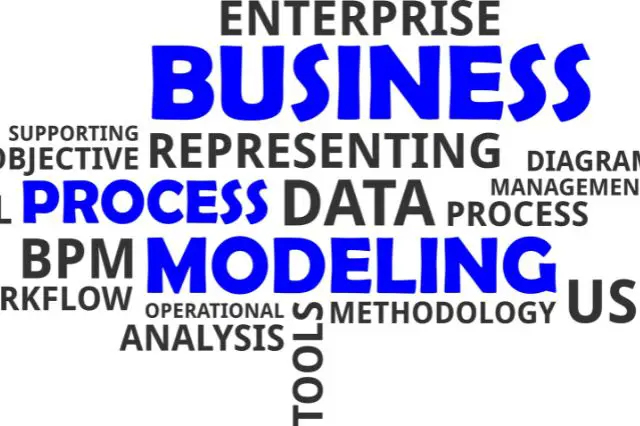Business
Business Process Modeling: What is it, and Why is it Needed?

What does a tailor do before making a dress? That’s right, the pattern! And what happens before the fashionable clothes end up in our closet? It’s a long process involving, among other things, the fashion show of the current season on the runways.
So a fashion collection, before it becomes mass and brings profit, goes through a modeling stage, when the developers think out the smallest nuances of cut, color, accessories, and combination of accessories. And only after the future dress is visualized on paper and in the cutting can you move on to creating a fashion collection of clothes.
Ideally, this is how any product to be launched on the market should go, and the business process for its production should be thoroughly thought out and planned. It is the case in large companies, and business process modeling has been invented for this purpose.
Today we will briefly talk about the business process modeling system which use popular free essay maker, why it is needed, and how it is applied. And we’ll start with a little historical background.
Modeling Business Processes: a Bit of History
The need to streamline manufacturing and business processes has become apparent with the development of the industry. The first business process modeling tools were aimed at visualizing all components of production, supply, sales, and everything an industrial enterprise engages in.
A pioneer in this field was the Polish engineer Karol Adamecki (1866-1933). In 1896, he presented monograms, which visualized everything happening at a given moment in a company.
Even then, in the 19th century, the language of science and business was English. Therefore, for the work to be widely known, it had to be at least released in English.
A much greater resonance was caused by the development of the British engineer Henry Gant (1861-1919). In 1910 he introduced a tape chart that allowed you to track the status of all processes in an enterprise at any given time. The development was named after its inventor – the Gantt chart. More than a hundred years have passed since then, but the Gantt chart is still relevant and allows to solve many organizational problems:
As production became more complex, so did the modeling of business processes of the enterprise. For example, PERT (Project Evaluation and Review Technique), which appeared in the 1950s, made it possible to work with many values, including uncertain and changing throughout the project.
Since then, the methodology of business process modeling has undergone some changes. In the most general terms, we can distinguish two main approaches, namely functional and object-oriented:
- The functional approach considers a function or operation as the basis, and the business process is represented as a sequence of functions.
- The object-oriented approach depicts the interaction of objects as production units without detailing operations but with a mandatory description of conditions and events on which the business process depends.
Sometimes the simulation approach or simulation modeling is distinguished as a separate approach. It involves modeling the behavior of business processes under different conditions, taking into account different internal and external influences, followed by an analysis of the dynamic characteristics of processes and resource allocation. We can say that simulation modeling includes elements of both functional and object-oriented approaches.
To date, various methods and notations of business process modeling are used, allowing you to choose the best for a particular area of activity.
Goals of Business Process Modeling
The ultimate goal of business process modeling and everything that happens in business is to increase profits. Analysis and modeling of business processes allow you to identify resources to reduce production costs, increase market capacity, increase product value to customers, and other important aspects of achieving the ultimate goal.
Why model business processes:
- To form an “outside view” and see the strengths and weaknesses of the process.
- To regulate the process, to form clear rules, conditions, and norms of the process execution.
- Establish a link between the processes and the requirements they must meet.
- Allocate responsibilities and authority between participants.
- Present process data in an easy-to-understand format.
- Optimize decision negotiation chain.
- Optimize the system of control over the implementation of decisions and the quality of the product and/or service.
- Balance inventory of raw materials and goods.
- See the prospective need for resources (material, informational, human).
- Forecast the project budget and minimize possible deviations from estimates.
- Increase the flexibility of project management.
- Ensure customer satisfaction control.
- Ensure transparency of processes for investors.
The detailed description, analysis, and modeling of business processes allow you to organize and balance everything that happens within the production cycle, sales, marketing, and planning of new products. How do we achieve these goals given the variety of today’s methods by modeling business management processes? To do so, we have to follow certain principles.
Principles of Business Process Modeling
We have already started to talk about the fact that there are different approaches to modeling the business processes of an organization and enterprise. It is hardly possible to cover everything at once. Hence, it is important to define your priorities and understand should your attention be focused on business processes properly or whether the interaction between all the constituents of the business process is much more important.
After defining the approaches, it would be easier to understand which business process design models best fit the goals. So, what principles should modeling be based on?
Top 10 business process modeling principles:
- Orientation to reference and reference models as a basis for business process description.
- The integrity of the process is described to obtain comprehensive information.
- Top-down modeling from top-level models to bottom-level models.
- Reasonable sufficiency in the description, detailing, number of objects, and links between them.
- Focus on key process parameters without distraction to minor details.
- The commensurability and proportionality of the resources (material, time, human) spent and the result obtained.
- Multiplicity is an understanding that the model should reflect the object’s properties that affect the desired performance.
- Multiplicity uses several models for a complete comprehensive representation of an object or process if one model is insufficient.
- Consistency understands that all elements included in the model should have a clear, unambiguous interpretation and not contradict one another.
- Applicability of models about the purpose of the project.
And just as a fashion collection goes from a designer’s sketch to a finished dress, modeling business processes is a voluminous, multidimensional work involving many stages.
Stages of Modeling Business Processes
So what are the stages of business process modeling for a model to be effective?
The five main stages of modeling:
- Creation of the model in the most general form “as is” with identifying the boundaries and the main components of the process, collecting all necessary information.
- Data analysis, including finding constraints, weaknesses, duplications of functions and operations, and opportunities to improve the model.
- Building a desired “as it should be” model describing the state of the process to strive for.
- Testing the model by implementing and evaluating the results.
- Improvement of the model, taking into account the nuances identified during testing.
In addition, you should allow for “free play” in case of unforeseen circumstances to quickly adjust and/or modify the model if the fundamental conditions are affecting the planned result change. How to do all this? This requires special tools.
Business Process Modeling Tools
We already started talking about tools when we did a little historical background. The Gantt chart, the flowchart, the PERT method, and various notations are all tools that allow you to represent business processes in a work-friendly way.
Now we will overview the most popular methods used in the real economy. You will see familiar names and acronyms in this review, so let’s clarify in advance that, in some cases, the method and notation may have the same name.
How Do You Avoid Mistakes in Business Process Modeling?
As we know, only those who do nothing make no mistakes, but it would be unwise to waste time on typical mistakes that have already been made before you. Most mistakes are either a lack of understanding of the business process to be modeled or poor knowledge of modeling tools.
The “Sagging” of any component leads to the fact that the model will not work correctly. If a company starts to engage in “modeling for the sake of modeling,” it also does not give the desired result of process optimization and profit. A superficial approach naturally leads to the fact that simulation does not produce the expected effect, and the model is often incomprehensible to either management or staff.
Ideally, it is better to turn to professionals who know the mathematical apparatus and modern modeling methods for such highly specialized services. It should be done at least if you have never been involved in such modeling and design and have no experience applying theoretical knowledge in practice.
However, suppose you are confident that no one knows your business better than you. In that case, trying to create a model yourself is quite possible, especially since there is already some experience avoiding typical modeling mistakes.
Top 5 recommendations on how to avoid modeling mistakes:
- Stick to the chosen method and chosen notation. Conventionally speaking, if you start building a model through BPMN or FlowChart, use one method to build one model.
- Clearly define the boundaries of the business process. No one knows better than you what should happen within the business, so it is important to avoid both too general an approach and excessive detailing of planned operations.
- Avoid “overlapping” processes. A schematic representation of business processes as a sequence of actions is required to avoid confusion and clearly understand what happens in what sequence and under what circumstances it is possible to revert to one or another action.
- Remember that all modeled processes should have a single objective. Avoid situations where any process is modeled in isolation from the overall work and overall project goals.
- Apply homogeneous detailing. Simply speaking, all descriptions, variants of representation of operations, etc., should be reduced to a “common denominator” to avoid misunderstanding and misleading interpretations.
So we’ve figured out what modeling business processes is. In capable hands, this is a very powerful tool for improving business, giving visible results in the short term.
Finance
4 Reasons You Should Care about Your Credit Score


If applying for a small business loan, your credit score can make or break your chances of securing one and getting a good interest rate.
Whether starting a business, looking to expand, or requiring funds for other purposes, you may one day need a business loan. Getting the best terms possible is a priority. That’s one reason to consider your creditor score and how it’ll factor into your search for a business loan.
Here are four reasons your credit score matters. You’ll also see how to get help with credit score disputes if you can’t resolve such conflicts independently.
1. Credit Score Determines If You Get a Business Loan
If getting a business loan is a make-or-break issue for your company, you should be mindful of your credit score. Remember that lenders aren’t in the business of offering loans to people who present a substantial risk.
So, if your credit score is less than optimal, lenders could balk at lending you a loan or offer less money to reduce their risk. It’s a good idea to consider your credit score to see if you can realistically qualify for a business loan with reasonable terms.
Otherwise, you may have to explore other options to secure money for business needs. There are alternative ways to get funds. But it might mean accepting a higher interest rate or onerous terms.
2. Credit Score Affects Your Interest Rate
Even if you qualify for a business loan, you may not get a good interest rate if your credit score isn’t good. Even a few percentage points more could translate into paying back thousands more to complete your payback obligations.
You’ll have to consider whether you can afford to shoulder a high premium in interest payments to get a business loan you might not qualify for otherwise.
If forced to pay higher interest for a business loan, the lender may have other stringent terms. You should carefully consider the particulars before signing on the dotted line.
3. Credit Score Can Impact How Much You Qualify for
As was mentioned above, your credit score can influence how much a lender is willing to lend. If your credit is not good enough to grant you the amount you want, a lender may offer a business loan for a fraction of that sum.
That can happen when a lender doesn’t feel comfortable enough lending you more than a specific amount. It’s about limiting the potential fallout if you’re unable to pay your loan.
When a lender looks at your finances, it’ll know how much you can afford to pay back. If it determines you’ll struggle to pay back the amount you request, it might simply offer a lower amount more in line with your cash flow.
4. Credit Score Can Throw a Wrench in Your Business Plans
You may struggle to grow your business if you desperately need a business loan but have poor credit. In fact, you may face financial problems that threaten the long-term viability of your company. So, your credit score can make or break your business. Don’t allow bad credit to throw a wrench into your plans. If possible, improve your credit score before applying for a loan.
While a bad credit score can cause problems for your business, there are times when your credit report may include inaccurate information. Whether the credit report hasn’t been updated or includes completely false information, you may struggle to get the information corrected.
If you can’t make progress on this front, you may need to speak to a lawyer. A legal professional experienced in helping clients involved in credit score disputes can be a godsend.
Business
How Has E-commerce Evolved?


E-commerce has a relatively short history in business. The earliest incarnations of e-commerce stretch back to the 1970s, when early technologies such as teleshopping and Electronic Data Interchange helped to create a primitive version of this form of commerce.
However, modern e-commerce started to take off in 1994 when the entrepreneur Jeff Bezos set up Amazon from his garage. Initially, Amazon was an online marketplace just for books. In the years that followed, the range of products available increased.
Today, millions of unique products can be bought on the site, which has led it to become known as “the everything store.” Today, there are estimated to be over 26 million e-commerce websites worldwide, with around 13 million based in the US.
The e-commerce sector has grown rapidly and is predicted to continue to enjoy year-on-year growth for the foreseeable future.
However, in its relatively short history, there have been several developments that have shaped how companies operate online. In addition, consumer behavior and shopping preferences have changed as people regularly buy products and services online.
In this article, there will be a discussion of how e-commerce has evolved. Some key examples will be used to support this.
Social media promotion is integral to the sector
In the early days of e-commerce, there was far less competition between businesses because there were far fewer e-commerce firms. The internet has grown at an exponential rate since the early 1990s, and consumers can now find virtually any product, service, or specialist e-commerce firm online.
Due to the massive growth in the e-commerce sector, online firms now need to have a comprehensive marketing plan to promote their site and their products. This is vital to allow companies to stand out in an increasingly crowded online marketplace.
A key marketing strategy for millions of e-commerce firms is leveraging social media promotion’s power. Popular social media sites such as TikTok have around 1 billion monthly users, which makes the site a prime avenue for online promotions.
There is a global community of visitors to the site, which encompasses a wide range of demographics and target markets. Today, most e-commerce sites will have a marketing budget specifically for social media promotions.
They will create short but memorable adverts (typically using video) and will ensure that a hyperlink is embedded in the advert that takes the viewer to the product page of their website.
This simple strategy transforms customer interest into a sale with the lowest number of steps required on the part of the consumer. In short, social media promotion is a vital activity for any e-commerce firm and helps them to stand out in an increasingly crowded online marketplace.
The changing attitudes to delivery
In the early years of e-commerce, consumers understood that delivery timescales may be relatively long. Many customers were starting to buy from international sellers or fledgling e-commerce firms in their own country. During the early stages of e-commerce, there were few advanced delivery networks for online firms.
During the 1990s typical delivery timescales were far longer than today. Most products would take at least five days to arrive and potentially could be in transit for weeks.
Whilst consumers tolerated these timescales in the early days of e-commerce, they now expect quicker delivery schedules. In addition, if the stated delivery period is not adhered to and there are delays, many customers will stop using the e-commerce site.
As consumer delivery expectations increase, e-commerce firms must ensure that they can work with dependable and efficient shipping and courier firms. Companies such as Shiply USA may be ideal for smaller e-commerce firms that do not have their own delivery networks.
Such firms can offer highly competitive prices for shipping a range of goods. In addition, they have built a reputation for delivering to pre-stated timescales, with minimal levels of damage to items in transit.
In short, all e-commerce firms need to forge strong working relationships with professional shipping firms who can deliver on time and with competitive fees.
The rise of chatbots in online customer service
Finally, modern online shoppers expect that any queries or questions that they may have will be answered swiftly with excellent customer service. Not receiving a timely response to their correspondence creates a negative perception of the company and may make them less likely to purchase from the site.
E-commerce firms have been quick to recognize the value of swift responses to customer queries and are increasingly using AI to facilitate this. Chatbots are now widely used in e-commerce. They are programmed to understand language and detect the key question raised, directing customers to specific web pages with information on the topic.
This can help customers get the information they need and reduce the reliance on a large human customer service team, keeping such staffing costs low.
Business
8 Tips for Better Product Consistency


When it comes to building a business that people trust and recognize, there’s no replacement for consistency. More specifically, you need the quality and output of your products to be consistent across the board.
However, with so many different moving parts involved, this is often easier said than done.
- Standardize Your Processes
Start by examining your current processes and how things are being handled at every step of the production process:
- Are they documented?
- Where are they documented?
- Is there a clear blueprint that everyone can follow?
Standardization is the backbone of consistency. It involves setting clear guidelines for every stage of your production, from the initial design to the final output. This means having detailed, step-by-step instructions that leave no room for ambiguity.
It’s a smart idea to implement checklists and workflows, which are easy for people to follow. This ensures every product goes through the same procedure, minimizing variations that can lead to inconsistencies.
- Implement Rigorous Quality Control
Quality control is non-negotiable. With that in mind, introduce systems that scrutinize your products at multiple stages of the production process. This might involve regular spot checks, pre-shipment inspections, and even post-market quality assessments.
The goal of quality control is to catch and address any deviations before they reach the customer. Consider adopting statistical quality control techniques like Six Sigma, which can help you measure, analyze, and reduce variability in your manufacturing process.
- Leverage Technology and Automation
Don’t ignore the resources you have available at your fingertips. This includes technology and access to outside partners.
In terms of tech, automation has the ability to reduce human error and ensure that each part of your product meets exact specifications. When it comes to outside partners, you can always hand off parts of your process to an experienced contract assembly company to make sure you get the same result every single time a product is packaged.
- Train and Engage Your Employees
Your employees are the real MVPs behind your product, and their skills and commitment play a pivotal role in consistency. Even if the majority of the production is happening with the help of automation, it ultimately comes down to the people who are implementing the systems, spot-checking the production processes, and keeping everything running.
The best thing you can do is invest in comprehensive training programs that teach your employees about the technical aspects of their jobs while instilling a deep understanding of the importance of consistency. Engaged employees who share a commitment to your brand’s standards are less likely to cut corners and more likely to maintain high quality in every task they perform.
- Gather and Utilize Feedback
Feedback is a powerful tool – don’t ever forget it. While not always comfortable – and quite often painful – gathering feedback forces you to come eye-to-eye with how you’re actually doing. (Not just how you think you’re doing.)
Gather input from your customers, employees, and even suppliers on a regular basis to find out where there might be inconsistencies in your product. This can provide invaluable insights into areas that may need adjustment. Use this feedback to fine-tune your processes and training, ensuring that your products continually meet customer expectations and industry standards.
- Monitor and Adapt Your Supply Chain
The consistency of your product is also highly dependent on the materials you use. Variability in materials can lead to variability in the final product. Keeping this in mind, build strong relationships with reliable suppliers whose products meet your quality standards.
Regular audits and supplier evaluations can also go a long way towards helping ensure that the materials you receive remain consistent in quality and function.
- Set Realistic and Clear Expectations
While striving for perfection, set realistic expectations for your team and your processes. This might seem like an oxymoron, but it’s all about your mentality. Perfection is always the goal, but you also have to remember that people are people – meaning they will make mistakes.
Don’t accept these mistakes, but also don’t ruin relationships when people don’t live up to the goal of perfection. Instead, go back to the drawing board and find ways to limit those mistakes in the future.
- Prioritize Continuous Improvement
The journey to product consistency is one that never ends. Markets evolve, technologies advance, and customer preferences change. Maintain a mindset of continuous improvement, regularly reviewing and refining your processes to adapt to new challenges and opportunities.
This proactive approach will keep you ahead of the curve, ensuring your products consistently meet the high standards your customers expect.
Invest in Consistency
If you make a commitment to product consistency, you’ll never regret it – not even for a day. It can be costly and time-consuming on the front end, but it’s one of the most financially rewarding investments you’ll ever make in the long run.
Start with the tips highlighted in this article and begin shifting your focus in a new direction!
-



 Captions3 years ago
Captions3 years ago341 Sexy Captions to Fire Up Your Instagram Pictures
-



 Captions3 years ago
Captions3 years ago311 Night Out Captions for Instagram and Your Crazy Night
-



 Captions3 years ago
Captions3 years ago245 Saree Captions for Instagram to Boost Your Selfies in Saree
-



 Captions3 years ago
Captions3 years ago256 Best Ethnic Wear Captions for Instagram on Traditional Dress
-



 Captions3 years ago
Captions3 years ago230 Blurred Picture Captions for Instagram
-



 Captions3 years ago
Captions3 years ago275 Deep Captions for Instagram to Express Your Thoughts
-



 Quotes3 years ago
Quotes3 years ago222 Nail Captions for Instagram to Showcase Your Fresh Manicure
-



 Captions3 years ago
Captions3 years ago211 Laughing Captions for Instagram | Laughter Is the Best Medicine







